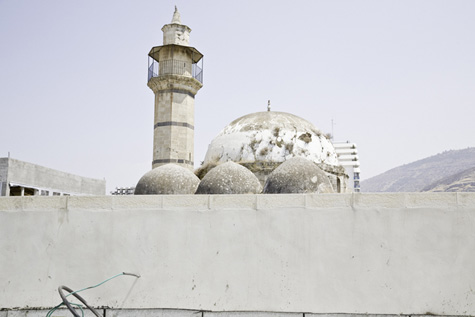
TELLING JUXTAPOSITIONS Wells says his photos depict “India marching backwards into the future.” |
One of the questions in fine art is how to address the big issues of today, from our wars to global warming. We used to have “history painting” for this sort of thing — think Emanuel Leutze’s Washington Crossing the Delaware or Picasso’s Guernica. But in the high precincts of fine art that style has become nearly extinct except for a handful of folks like Peter Saul and maybe Jeff Wall, Luc Tuymans, or Fernando Botero.
This state of affairs is a legacy of 20th-century Modernism, which made a beeline for apolitical abstraction, and subsequent Post-Modernism, which wandered into an aesthetic maze of mirrors in the late 1970s and keeps reporting back that everything’s meaningless. And it’s tied up with the rise of photojournalism — which during the 1930s Depression and World War II filled our need for images of important events — and then television. But as photography and video came to be embraced by art institutions in the 1960s and ’70s, formal experimentation and personal concerns were favored, while photojournalism was shunted into a separate, lesser category called commercial art.
Since then, the fine art world has developed meaty ways to speak of race, gender, and sexuality, but it struggles to find substantive means to address war, poverty, economic crisis or, say, the coming 2012 apocalypse.
I bring this up because of the pairing of photographers David H. Wells of Providence and Deborah Bright of Boston in an exhibit at Chazan Gallery at the Wheeler School (228 Angell Street, Providence, through December 9). Both seem to be feeling their way around the question of how to address big societal issues in fine art.
During trips to Israel between 2005 and ’08, Bright, who is dean of fine arts at RISD, adapted the aloof formal style of much of today’s art photography to the charged subject of the ruminants of Palestinian communities that were driven out by Jewish forces during fighting that bracketed the creation of the state of Israel in 1948.
In Haifa, she photographed decaying brick and concrete Palestinian buildings, now overgrown by weeds and encroached upon by modern Israeli glass and steel towers. In a gal-lery handout, Bright writes, “The ruminant of Palestinians who still live in Haifa are forbidden by law to purchase or renovate these buildings.” New condos abut old Palestinian homes in Jaffa. An old gate stands orphaned and alone at the edge of a suburban houses in al-Abbasiyya; a sign knocked to the ground in the deserty scrub of Khirbat al-Lawz an-nounces (Bright’s translation explains) a proposed national museum of Israel’s wars.

ALOOF Bright’s Al-Omri Mosque. |
On one hand, these parched urban scenes are time capsules. “What remains of former Arab habitation in these places has become increasingly difficult to identify,” Bright has written, “but their character as open wounds is palpable.” On the other hand, they can feel like clear-eyed but innocuous architecture studies. Part of it is Bright’s detached style, which includes the complete absence of people. When art about such a contentious subject is so polite is something missing?
David H. Wells groups photos — as in midcentury magazine picture essays or medieval altarpieces — looking for telling juxtapositions in his series “Concurrence: India march-ing backwards into the future.” The photos were taken during visits to India between 1995 and 2008 and then grouped in 2007 and ’08 to show how old Indian traditions are meet-ing the global economy.
Labor — Old & New features two photos of bare feet, one in a pile of rice, the other atop a pile of broken computer parts. Workers — New & Old shows, on the left, a guy behind a com-puter, and, on the right, men hauling nets in water turned purple by the reflected sunset. The triptych Media Imagery shows Indian women in headscarves and voluminous dresses passing giant billboards of scantily clad (generally white) gals advertising cosmetics.